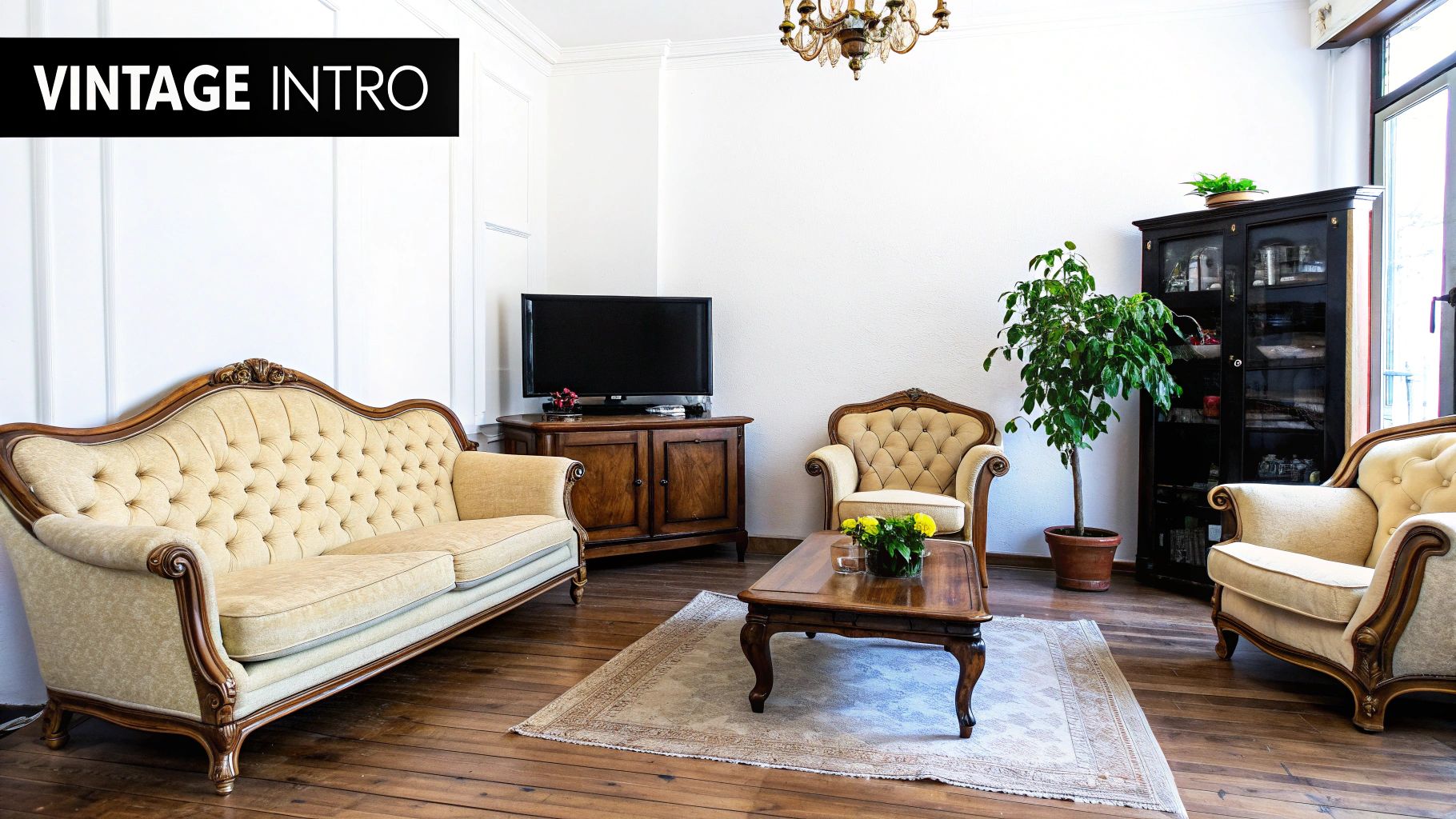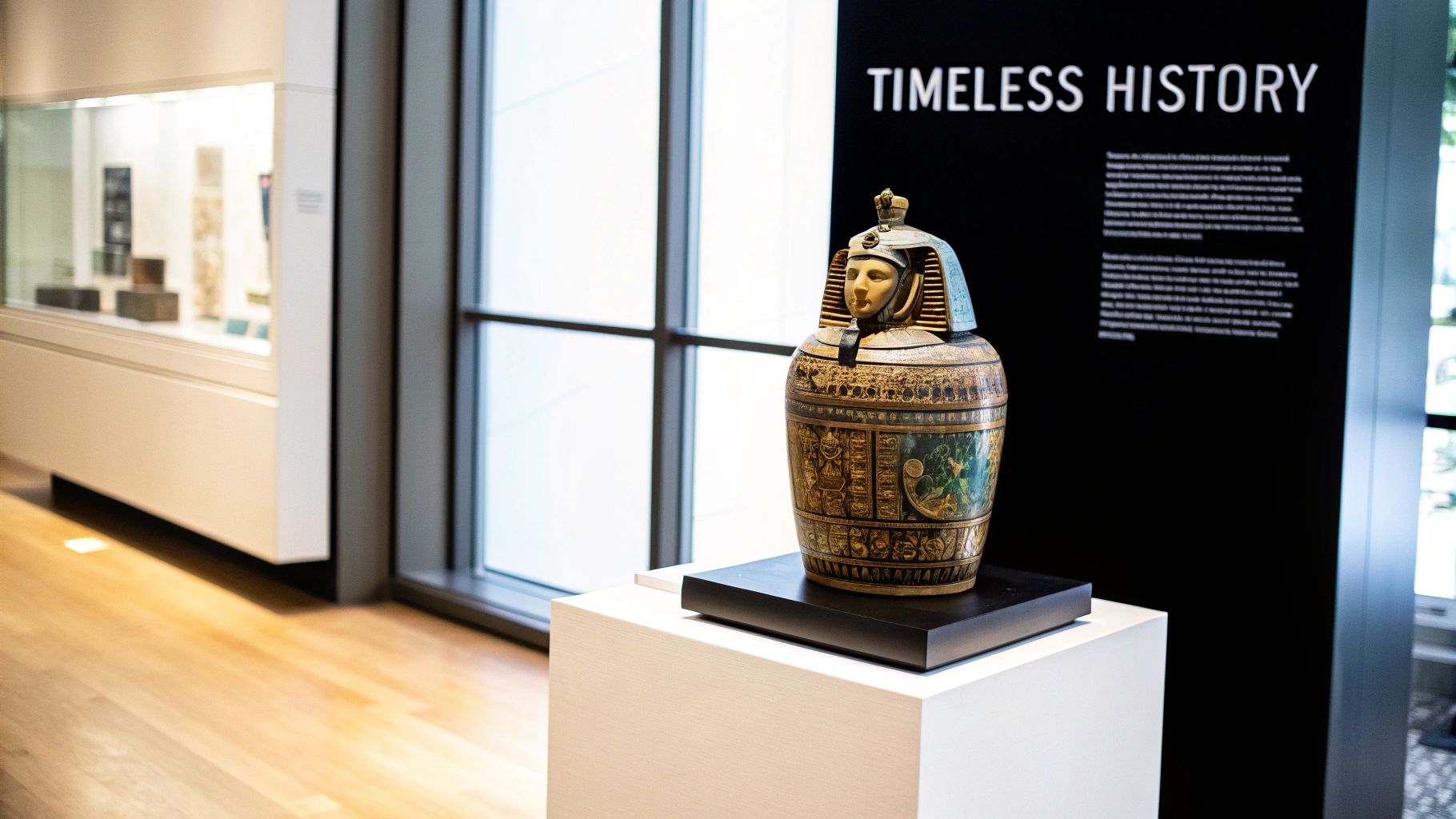Antique Chair Identification Guide: Spot Hidden Treasures
05.21.25

The difference between a valuable antique and a costly replica often hinges on proper identification. This essential skill empowers you to confidently navigate the world of vintage furniture, transforming casual browsing into strategic acquisitions. Understanding a piece’s nuances significantly impacts its value, influencing both buying and selling choices. Imagine overlooking a rare treasure or, conversely, overpaying for a clever fake. This highlights why accurate identification is paramount. In this article, we hope to make you a master in how to identify vintage furniture.
Proper authentication can dramatically alter a piece’s worth. Picture finding a chair resembling a classic Eames design. Verifying its authenticity through maker’s marks or construction methods could significantly increase its value. Conversely, a seemingly antique dresser lacking provenance or displaying inconsistent construction could be a less valuable reproduction. These scenarios demonstrate how identification protects your investment and maximizes returns.
Manufacturer identification is crucial for assessing value. Pieces bearing the mark of a renowned maker often command substantial premiums. In fact, manufacturer identification is so critical for valuation that marked pieces can sell for 30-50% more at auction. Early 20th-century manufacturers like Thonet (est. 1853) left distinctive marks – their bentwood chairs feature 6-8 steam-bent components and, starting in 1890, paper labels. Online auction records show documented Gustavian-style pieces (1770s-1810s) fetching 15-20% higher prices than unverified counterparts in Scandinavian markets. Research indicates that 60% of high-value vintage furniture is traceable through catalog comparisons, with digitized 1920s-1950s catalogs helping attribute 1 in 3 unknown pieces. Learn more at Rime Home. Knowing which manufacturers used specific materials or construction techniques unlocks a piece’s true value.
Even seasoned collectors continually hone their identification skills. They understand the market’s dynamic nature, with new reproductions and previously unknown pieces emerging regularly. By staying informed about trends and studying historical information, astute collectors transform casual browsing into a strategic pursuit. They’re prepared to recognize undervalued pieces and make informed purchases. This emphasizes how continuous learning is essential for success in the vintage furniture market.


The construction of a piece of furniture often speaks volumes about its age. Examining the assembly reveals clues about its origins, helping you differentiate between a treasured antique and a modern reproduction. This involves understanding how techniques have changed over time, reflecting both the craftsmanship of the era and the available technology. The joinery, or how wooden components connect, provides essential dating clues.
One key element to study is the dovetail joint. These interlocking pieces of wood, resembling a dove’s tail, are a sign of quality construction. Hand-cut dovetails, frequently found in older pieces, have slight imperfections and variations in size and spacing.
This appealing irregularity contrasts sharply with the precise, uniform dovetails made by machines in more modern furniture. The difference is akin to comparing a handwritten letter with a typed one. The handwritten note possesses a unique personal touch, while the typed one appears standardized. This difference makes it easy to distinguish between hand-crafted and machine-made furniture.
Certain construction methods simply weren’t around in earlier times. The use of staples, Phillips head screws, or plywood typically signifies a more recent creation. On the other hand, the existence of hand-forged nails or wooden pegs points toward an older piece.
Knowing these later “shortcuts,” which weren’t shortcuts in their time, provides important clues about authenticity. This is especially valuable for identifying vintage furniture. For more information, check out this helpful resource: How to master…
Identifying vintage furniture hinges on construction techniques and material analysis. Before 1850, pieces often showcased hand-cut dovetail joints and a certain irregular symmetry. 18th-century chairs, for example, often exhibit 3-5mm tool marks from hand carving.
After the Industrial Revolution (post-1850), machine-cut precision became more prominent, with symmetrical parts becoming standard by 1900. Mid-century modern furniture (1940s-1960s) saw over 70% of designs using teak or walnut, with iconic pieces like Eames chairs displaying distinctive organic curves and tapered legs.
The furniture market reflected these changes. Authenticated mid-century pieces experienced a 200% price jump between 2010 and 2020 in significant markets like the US and EU. Learn more about vintage furniture.
Production techniques evolved with technology, significantly impacting furniture construction. Understanding these changes enhances your ability to date a piece. The introduction of steam bending in the 19th century, for instance, enabled the creation of curved furniture previously unimaginable. Likewise, readily available plywood in the 20th century influenced furniture design and construction.
To understand a piece’s history and value, a holistic examination is key – from the type of wood to the upholstery method.
To illustrate the evolution of joinery, consider the following table:
This table shows how furniture joinery methods changed across different time periods, helping collectors identify when a piece was likely made.
| Time Period | Joint Type | Characteristics | Common Tools Used |
|---|---|---|---|
| Pre-1850 | Dovetail (hand-cut) | Irregular, varying sizes, unique to each piece | Hand saws, chisels |
| Post-1850 | Dovetail (machine-cut) | Precise, uniform, identical repetitions | Dovetail jigs, routers |
| 19th Century | Mortise and tenon, dowel | Strong, versatile, suitable for steam bending | Chisels, mallets, drills |
| 20th Century | Butt joints, screws, staples | Faster, simpler, suited for mass production | Power drills, staple guns |
This table highlights the shift from labor-intensive hand techniques to more efficient machine methods. The increasing use of simpler joinery types reflects the demands of mass production and the availability of new materials and tools.

Authenticity in vintage furniture goes beyond mere aesthetics; it’s intrinsically tied to the materials used in its construction. Much like the rings of a tree tell its life story, the materials of a furniture piece whisper tales of its age and origins. While reproductions might imitate the outward appearance, they often fail to capture the essence of genuine materials and their unique aging process. This section delves into identifying period-specific materials and recognizing their distinctive characteristics.
The first step in identifying vintage furniture involves recognizing materials typical of specific periods. Different eras favored distinct resources. For instance, the Arts & Crafts movement (1880-1920) prominently featured oak, while the mid-century modern period (1940s-1960s) witnessed a rise in the use of teak and walnut. Metals and fabrics follow similar timelines. Chrome plating, for example, gained popularity during the Art Deco period (1920s-1930s). Understanding these material preferences is fundamental to accurate identification. You might be interested in: Our guide on different wood types.
Patina, that unique surface appearance developed through years of use and exposure, is virtually impossible to replicate flawlessly. This natural aging process results in distinct wear patterns, color variations, and textural nuances that serve as markers of authenticity. Some reproductions attempt to simulate patina through artificial distressing techniques, but these often appear uniform and lack the organic irregularity of natural wear. Think of the difference between a naturally weathered stone and a newly carved imitation – the former carries the weight of time, while the latter lacks the same depth of narrative. Recognizing the subtle characteristics of true patina is crucial for any vintage furniture enthusiast.
Environmental conditions play a significant role in a piece’s aging. Sunlight, humidity, and temperature fluctuations all contribute to the distinct personality of authentic vintage furniture. Prolonged sun exposure, for instance, can cause wood to lighten or darken, while humidity changes may lead to subtle expansion or contraction, resulting in characteristic cracks or separations. These environmental imprints become interwoven with the furniture’s history, adding layers of authenticity difficult for reproductions to achieve.
To further illustrate the connection between materials and time periods, let’s examine the following table:
To help visualize the evolution of furniture materials across different eras, the table below provides a concise overview. It outlines common materials and techniques used, aiding in the identification and dating of furniture pieces.
| Time Period | Primary Woods | Secondary Materials | Finishing Methods |
|---|---|---|---|
| Victorian (1837-1901) | Mahogany, Walnut | Velvet, Horsehair, Marble | Shellac, Wax |
| Arts & Crafts (1880-1920) | Oak, Maple | Leather, Copper, Brass | Fumed Finishes, Oil |
| Art Deco (1920s-1930s) | Rosewood, Ebony | Chrome, Glass, Lacquer | High-Gloss Lacquer, Gilding |
| Mid-Century Modern (1940s-1960s) | Teak, Walnut | Vinyl, Formica, Aluminum | Lacquer, Oil |
This table demonstrates how materials and techniques have evolved over time, reflecting the design trends and technological advancements of each era. Recognizing these trends can provide valuable clues in identifying and dating vintage furniture.
Material timelines often provide essential clues for dating. For example, Victorian-era furniture (1837-1901) frequently utilized 2-3cm thick mahogany boards, whereas 1950s laminates typically measured a mere 0.5-1.2cm. Original finishes also display distinct wear patterns. Shellac (common pre-1920s) flakes differently than post-1950s lacquers. Genuine wear typically exhibits scratch angles of 45-60°, contrasting with the more uniform distressing seen on reproductions. Furthermore, market data reveals correctly identified Arts & Crafts pieces (1880-1920) fetching €8,000-€120,000 at EU auctions, while misattributed pieces sell for 20-30% less. Authentication through multiple factors (joinery, materials, and provenance) increases valuation accuracy by 40-60% compared to reliance on a single factor. Explore this topic further here. By understanding how materials age and the elements that influence them, you can confidently differentiate between authentic vintage treasures and cleverly crafted imitations. This knowledge sharpens your identification skills and ensures you are investing in the true value of vintage furniture.

Identifying vintage furniture often feels like a treasure hunt. One of the most exciting parts is discovering maker’s marks, those little signatures left by designers and manufacturers. These marks can significantly increase a piece’s value and tell a story about its past. Let’s explore how to find these hidden gems and understand their significance.
Maker’s marks can be tricky to find. They often hide in plain sight. Check the underside of furniture, inside drawers, on the back of cabinets, and even within the upholstery. A tag sewn into a chair cushion, for instance, might reveal the manufacturer and production date. Metal tags or stamps often appear on the frames of chairs and sofas. Don’t forget to look in less obvious places, like the bottom of a table leg or the back of a mirror frame.
Maker’s marks come in many forms, from simple stamped initials and logos to complex labels and tags. Some manufacturers used numerical codes or symbols that require a little extra research. A series of numbers, for example, might indicate a specific production year or factory location. Online databases and antique guides can be invaluable resources. They offer a wealth of information, linking symbols and codes to specific manufacturers. Remember to check multiple sources to confirm your findings.
Marking techniques have changed over the years, reflecting advancements in technology and manufacturing. Early furniture makers often used hand-carved signatures or brands. With the rise of mass production, stamped labels and tags became more common. Understanding these historical changes can help determine a piece’s age. A paper label, for instance, might indicate a piece from the early to mid 20th century, while a burned-in brand might suggest an earlier origin. This helps narrow down the potential time period for your vintage discovery.
Even though maker’s marks are valuable clues, some renowned designers and manufacturers didn’t consistently mark their work. In these cases, recognizing characteristic stylistic elements becomes crucial. The use of certain materials, joinery techniques, or distinct design features can point to a particular maker or design movement. Just as fashion designers have signature styles, furniture makers often develop recognizable design elements. These elements, even without a maker’s mark, can help you identify vintage furniture.
Learning to spot the hallmarks of influential designers transforms casual browsing into strategic collecting. This knowledge helps you identify potentially valuable pieces even when maker’s marks are missing. It allows you to make informed purchases and possibly discover hidden treasures. With careful observation and research, you’ll train your eye to recognize the subtle details that distinguish authentic vintage furniture from reproductions. This skill is like developing a musical ear—the more you practice, the better you become at recognizing individual styles. This expertise makes browsing more rewarding, turning it into a hunt for authentic vintage finds.
Every furniture era has its own distinct visual language. These unique stylistic fingerprints tell a story about the piece’s origins. Much like an art historian can differentiate a Renaissance painting from a Baroque masterpiece, a trained eye can discern a true Victorian settee from a modern reproduction. This section will guide you through the key stylistic elements that define different furniture periods, giving you the confidence to identify vintage furniture.
The Victorian era (1837-1901) is characterized by ornateness. Think elaborate carvings, intricate inlays, and a preference for dark, rich woods like mahogany and walnut. This aesthetic reflected the era’s affluence and a deep fascination with intricate details. Victorian chairs, for example, often feature tufted upholstery, claw feet, and intricately carved backs. This focus on embellishment sets Victorian pieces apart from the more streamlined designs of later periods.
In stark contrast to the Victorian era’s opulence, the Art Deco period (1920s-1930s) celebrated geometric forms and sleek lines. Art Deco furniture frequently incorporates luxurious materials such as chrome, lacquer, and exotic woods. This reflects the era’s emphasis on glamour and modernism. A typical Art Deco chair might have a streamlined silhouette, geometric upholstery patterns, and polished metal accents, creating a distinctly modern look compared to the more ornate Victorian designs.
Mid-century modern furniture (1940s-1960s) prioritizes functionality and simplicity. Clean lines, organic shapes, and a preference for natural materials like teak and walnut define this iconic style. For more information, check out Our guide on furniture styles. A prime example is the classic Eames lounge chair, a quintessential mid-century piece. Its molded plywood shell, leather upholstery, and simple frame represent the period’s emphasis on comfort and understated elegance. However, subtle differences in proportions often distinguish authentic mid-century pieces from contemporary reproductions. The angle of a chair leg or the height of a sofa back can be telling indicators.
Recognizing authentic vintage furniture requires careful attention to detail. Subtle proportional differences can be key indicators of a piece’s age and authenticity. For example, authentic mid-century pieces often have specific leg lengths and armrest heights that are distinct from modern reproductions. This is a result of the designers’ careful consideration of ergonomics and human proportions during that era.
Certain decorative elements are specific to particular time periods. The use of Bakelite, an early plastic, for furniture hardware, for instance, typically indicates the Art Deco period. Similarly, the presence of brass ferrules on furniture legs often suggests a mid-century modern origin. These seemingly minor details are vital clues in determining a piece’s age. They serve as time stamps, connecting a piece to its historical context. For more information, read our article on how to master vintage furniture pricing. These elements can provide strong evidence of authenticity, even when maker’s marks are absent.
By understanding these stylistic nuances, you will develop the skills to identify period-specific elements and confidently date furniture. This knowledge transforms casual browsing into a focused pursuit, enabling you to discover valuable vintage treasures and avoid costly errors. It adds depth to the joy of collecting, allowing you to appreciate not only the beauty but also the historical significance of each piece you acquire. This deeper understanding enriches the experience of owning and cherishing vintage furniture.
Technology has transformed how we identify vintage furniture. We’re no longer limited to dusty library archives; essential information is now readily accessible online. This digital shift creates exciting opportunities for seasoned collectors and newcomers alike. Let’s explore how these resources have become indispensable for authentication.
Numerous websites specialize in vintage furniture identification. These resources offer a wealth of information, from databases of furniture makers to guides on historical styles. Online auction archives, for instance, like those found on LiveAuctioneers, offer valuable insights into pricing trends and past sales. These records can help you understand the market value of comparable pieces and make informed decisions. Manufacturer archives, such as those maintained by Herman Miller, often provide historical catalogs and product information. This data can be invaluable for verifying authenticity, especially for pieces with maker’s marks.
Several mobile apps cater specifically to vintage and antique collectors. These apps facilitate quick searches for information on styles, makers, and periods. Some even utilize image recognition technology. You can simply snap a photo, and the app will try to identify the style or origin. While not foolproof, these apps can be helpful starting points, such as the Antiques Navigator app.
Organizing research is key for efficient identification. Creating a personal digital reference library streamlines this process. This could involve bookmarking websites, organizing images of furniture styles, or compiling a spreadsheet of maker’s marks. This structured approach allows quick access to your compiled research. Having information readily available makes comparing and contrasting easier, improving identification accuracy.
Online communities provide forums for shared knowledge. These platforms connect enthusiasts who offer advice, share tips, and even assist with authenticating specific pieces. They can also alert you to newly discovered items or upcoming auctions. However, remember that information shared within these communities should be verified. Always double-check against reputable sources before making decisions. Facebook groups dedicated to specific furniture styles or eras are a good example.
Clear, detailed photos are crucial for remote authentication. When seeking expert opinions online, high-quality images are essential. Focus on capturing key details like joinery, maker’s marks, and unique features. Multiple angles and close-ups provide a comprehensive view.
A systematic research workflow ensures thorough authentication. This might involve checking online databases, researching historical production methods, or consulting experts. A defined workflow keeps your research organized and ensures you consider all relevant factors before purchasing. By merging traditional knowledge with digital tools, you can create a robust and effective system for vintage furniture identification.
Ready to furnish your home with unique, high-quality pieces? Whether you’re an expert in how to identify vintage furniture or not, shopping with us makes it easy. Explore our curated selection of vintage furniture at High End Used Furniture and discover treasures that will elevate your living space. We offer nationwide, safe, and hassle-free delivery.
High end used furniture